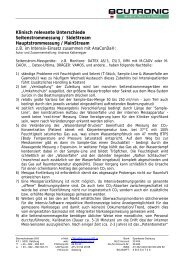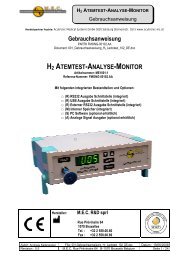Summary Carbon Monoxide Lurking within: The Danger of ...
Summary Carbon Monoxide Lurking within: The Danger of ...
Summary Carbon Monoxide Lurking within: The Danger of ...
You also want an ePaper? Increase the reach of your titles
YUMPU automatically turns print PDFs into web optimized ePapers that Google loves.
masimo corporation 40 parker irvine ca 92618 www.masimo.com<br />
Demystifying Carboxyhemoglobinemia - ED<br />
Clinical Effects<br />
<strong>The</strong> stakes for diagnosing and treating CO poisoning are high. Fast, effective treatment can do<br />
much to improve clinical outcomes and contain damage to the neurologic, cardiac, metabolic,<br />
pulmonary and renal systems <strong>of</strong> the body as described in Table 5.<br />
Table 5: Impact <strong>of</strong> CO Poisoning on the Body Systems<br />
Neurologic CO poisoning causes central nervous system depression<br />
presenting in a host <strong>of</strong> impairments. In mild cases, patients<br />
report headaches, dizziness and confusion. In severe cases,<br />
patients may be comatose or develop seizures. Long-term<br />
neurocognitive and neuropsychiatric sequelae are reported<br />
even after moderate to severe single exposures.<br />
Cardiac CO poisoning causes decreased myocardial function and vasodilatation<br />
and a decreased oxygen delivery to, and utilization<br />
<strong>of</strong>, oxygen by the myocardium. As a result, the patients may<br />
present hypotensive or with tachycardia, chest pain, arrhythmias<br />
or myocardial ischemia. Most deaths from CO poisoning<br />
ultimately result from ventricular dysrhythmias. 7 Long-term<br />
cardiac sequelae are reported even after moderate to severe<br />
single exposures, increasing the odds ratio <strong>of</strong> premature<br />
cardiac death.<br />
Metabolic Respiratory alkalosis (hyperventilation) is possible in mild<br />
cases. With severe exposure, metabolic acidosis may result in<br />
elevated levels <strong>of</strong> acid throughout the body.<br />
Pulmonary Pulmonary edema occurs in 10 – 30 percent <strong>of</strong> acute CO<br />
exposures. 7 This may be due to a direct effect on the alveolar<br />
membrane, left ventricular failure, aspiration or neurogenic<br />
pulmonary edema.<br />
Multiple Organ Failure At high levels, multiple organ failures are expected, with a<br />
lethal outcome likely without immediate treatment to remove<br />
the CO.













